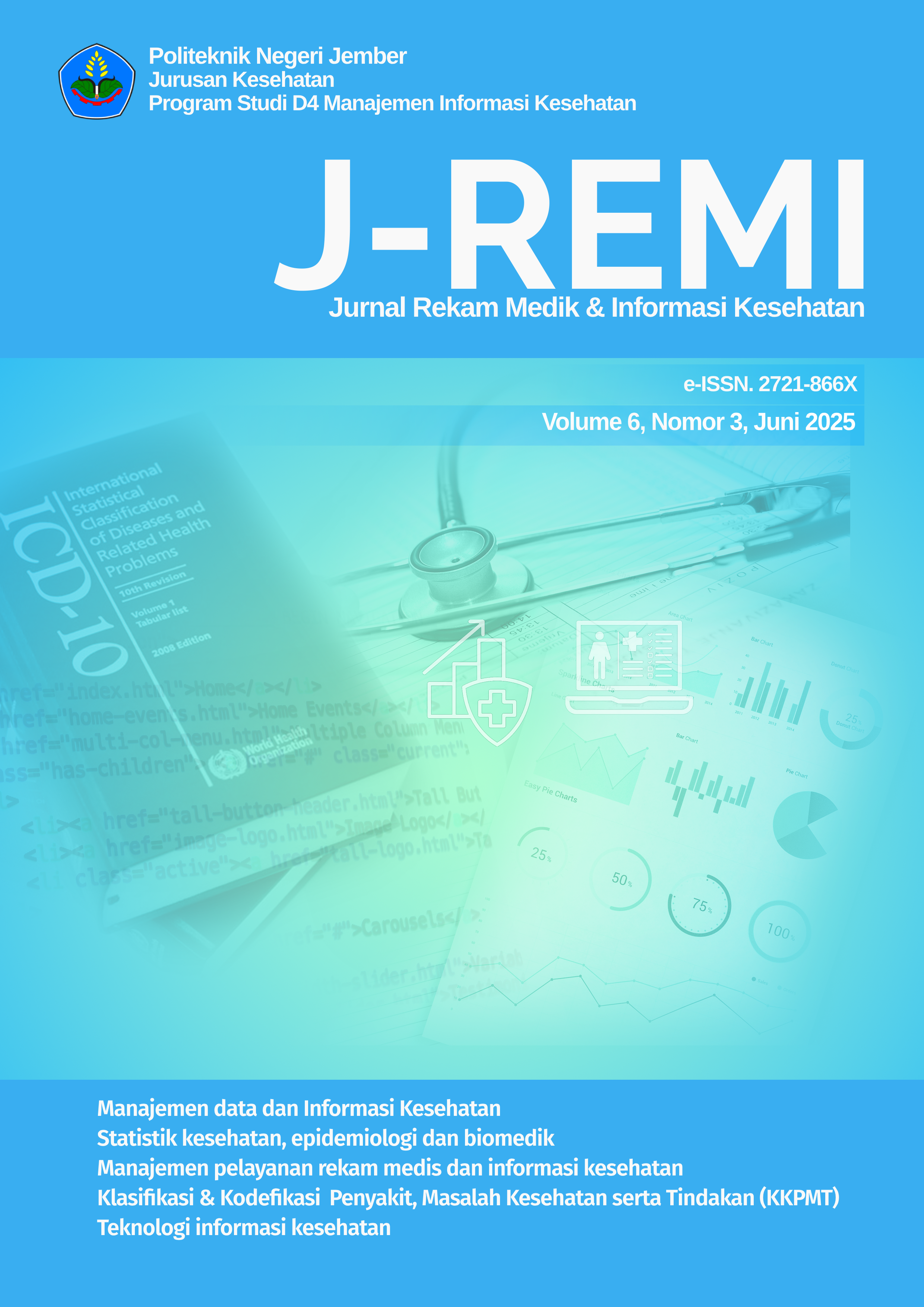Sistem Deteksi Dini Pneumonia Balita Berdasarkan Rekam Medis Menggunakan Algoritma C4.5
DOI:
https://doi.org/10.25047/j-remi.v6i3.5369Keywords:
C4.5, Pneumonia, Public Health Center, Medical RecordAbstract
The detection of pneumonia cases in children under five at Jabung Public Health Center has not reached the targeted rate. From 2019 to 2022, the number of identified cases remained below the expected target of 4.45%. This study aimed to design and develop an early detection system for childhood pneumonia based on medical records using the C4.5 algorithm. The research applied the waterfall development method and utilised data collection techniques including interviews and document analysis. The subjects were program officers for childhood pneumonia and medical record staff, while the objects were medical records of children diagnosed with pneumonia and acute respiratory infections (ARI). System development involved several stages, starting with data preprocessing, including data cleaning, selection, reduction, and transformation. Data mining was conducted using the C4.5 algorithm with the help of RapidMiner software. The result was an early detection system tailored to the needs of Jabung Public Health Center. The system achieved an accuracy rate of 97.50% based on the confusion matrix. This system was expected to assist health workers in identifying pneumonia cases in children more effectively, thereby improving disease monitoring and early treatment efforts at the community healthcare level.
References
[1] J. P. Goyal et al., “Risk Factors for the Development of Pneumonia and Severe Pneumonia in Children,” Indian Pediatr., vol. 58, no. November, pp. 1036–1039, 2021.
[2] R. L. Abdjul and S. Herlina, “Asuhan Keperawatan Pada Pasien Dewasa Dengan Pneumonia: Study Kasus,” Indones. J. Heal. Dev., vol. 2, no. 2, pp. 102–107, 2020, doi: https://doi.org/10.52021/ijhd.v2i2.40.
[3] S. N. Budihardjo and I. W. B. Suryawan, “Faktor-faktor resiko kejadian pneumonia pada pasien pneumonia usia 12-59 bulan di RSUD Wangaya,” Intisari Sains Medis, vol. 11, no. 1, pp. 398–404, 2020.
[4] N. F. Muhafidzah et al., “Faktor Faktor Risiko terjadinya Pneumonia pada Stroke Akut di RSUP Dr Hasan Sadikin Bandung,” J. Neuroanestesi Indones., vol. 10, no. 3, pp. 151–161, 2021.
[5] F. Faisal, Irwandi, R. Aprilia, Suharni, and Efriza, “Tinjauan Literatur: Faktor Risiko dan Epidemiologi Pneumonia pada Balita,” Sci. J., vol. 3, no. 3, pp. 166–173, May 2024, doi: 10.56260/sciena.v3i3.144.
[6] A. Zolanda, M. Raharjo, and O. Setiani, “Faktor Risiko Kejadian Infeksi Saluran Pernapasan Akut Pada Balita Di Indonesia,” LINK, vol. 17, no. 1, pp. 73–80, May 2021, doi: 10.31983/link.v17i1.6828.
[7] W. Sando, K. Kiswanto, and A. Alamsyah, “Pelaksanaan Program Pengendalian Penyakit Infeksi Saluran Pernafasan Akut (P2 ISPA) di Puskesmas Sungai Pakning Kabupaten Bengkalis,” J. Kesehat. Komunitas, vol. 4, no. 3, pp. 102–111, Feb. 2019, doi: 10.25311/keskom.Vol4.Iss3.269.
[8] Kementerian Kesehatan Republik Indonesia, Peraturan Menteri Kesehatan Nomor 25 Tahun 2014 tentang Upaya Kesehatan Anak. Jakarta: Kementerian Kesehatan Republik Indonesia, 2014.
[9] Dinas Kesehatan Provinsi Jawa Timur, Profil Kesehatan Provinsi Jawa Timur. Surabaya: Dinas Kesehatan Provinsi Jawa Timur, 2021.
[10] A. A. Wahid, “Analisis Metode Waterfall Untuk Pengembangan Sistem Informasi,” J. Ilmu-ilmu Inform. dan Manaj. STMIK, vol. 1, no. 1, pp. 1–6, 2020.
[11] M. A. Muslim, Data Mining Algoritma C4.5 : Disertai Contoh Kasus dan Penerapannya Dengan Program Komputer. Semarang: Universitas Negeri Semarang, 2019.
[12] A. Ardiyansyah, R. Saadah, L. Lisnawanty, and D. Purwaningtias, “Peningkatan Akurasi Metode C4.5 Untuk Memprediksi Kelayakan Kredit Berbasis Stratified Sampling Dan Optimize Selection,” Kumpul. J. Ilmu Komput., vol. 10, no. 2, pp. 239–249, 2023, doi: https://dx.doi.org/10.20527/klik.v10i2.636.
[13] A. Tristiyanto and Sriyanto, “Komparasi Uji Peformas Algoritma C4.5 DAN K-Nearest Neigbor Dalam Memprediksi Penyakit Diabetes,” in Seminar Nasional Teknologi dan Multidisiplin Ilmu (SEMNASTEKMU), Dec. 2022, pp. 379–389. doi: 10.51903/semnastekmu.v2i1.191.
[14] I. Lishania, R. Goejantoro, and Y. N. Nasution, “Perbandingan Klasifikasi Metode Naive Bayes dan Metode Decision Tree Algoritma (J48) pada Pasien Penderita Penyakit Stroke di RSUD Abdul Wahab Sjahranie Samarinda,” J. Eksponensial, vol. 10, no. 2, pp. 135–142, 2019.
[15] D. Y. Aziz, “Perancangan Dan Pembuatan Sistem Informasi Pendaftaran Pasien Rawat Jalan Secara Online di Puskesmas Kencong Kabupaten Jember,” Politeknik Negeri Jember, 2022.
[16] R. I. Borman and M. Wati, “Penerapan Data Maining Dalam Klasifikasi Data Anggota Kopdit Sejahtera Bandarlampung Dengan Algoritma Naïve Bayes,” J. Ilm. Fak. Ilmu Komput., vol. 9, no. 1, pp. 25–34, 2020.
[17] I. Budiman, S. Saori, R. N. Anwar, F. Fitriani, and M. Y. Pangestu, “Analisis Pengendalian Mutu Di Bidang Industri Makanan (Studi Kasus: UMKM Mochi Kaswari Lampion Kota Sukabumi),” J. Inov. Penelit., vol. 1, no. 10, pp. 2185–2190, 2021, doi: https://doi.org/10.47492/jip.v1i10.419.
[18] F. Soufitri, “Perancangan Data Flow Diagram Untuk Informasi Sekolah (Studi Kasus Pada SMP Plus Terpadu),” Reg. Dev. Ind. Heal. Sci. Technol. Art Life, vol. 2, no. 1, pp. 240–246, 2019.
[19] M. S. Novendri, A. Saputra, and C. E. Firman, “Aplikasi Inventaris Barang Pada MTS Nurul Islam Dumai Menngunakan PHP dan MySql,” Lentera Dumai, vol. 10, no. 2, 2019.
Downloads
Published
How to Cite
Issue
Section
License
Copyright (c) 2025 Tashya Eka Melinda, Mochammad Choirur Roziqin, Veronika Vestine, Muhammad Ifantara Putra

This work is licensed under a Creative Commons Attribution-ShareAlike 4.0 International License.






